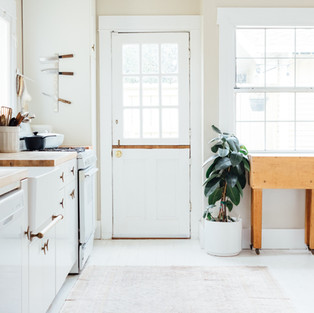
Design Elements:
Neutral shades are it's cornerstone; blacks, whites, tans and grays should make up the bulk of the design
Plenty of natural lighting is a must; windowed walls are very common
Ideally the room will feature at least one layered lighting element from each category: ambient, accent, and task
Borrows high functionality and streamlined surfaces from the modernist design movement, but its style often incorporates traditional ideas as well for a sleek but livable feel
Classic yet thoroughly of the moment
Timeless simplicity, minimalist aesthetic, quiet drama, clean lines, plays on texture, and uniquely bold
Borrows elements from many other styles (modern, traditional, art deco, futuristic, etc.)
Constantly able to evolve
Textured structural elements like molding and exposed brick walls and pipes add character
Straight and horizontal lines are a very common feature
Fixtures and other accents are typically made of metal, natural wood, stone or opaque/clear glass
What is "Contemporary" Style?
At it's core, the word "contemporary" means "of the moment" or "in the now". This makes it particularly difficult to define. This unique style borrows elements from other aesthetics with nods to modern, traditional, art deco, and futuristic designs. Because of this, it's able to easily evolve with the times. In today's day-and-age, the "in the now" style consists of curved lines, neutral colors, and minimalism. Who's to say what it might be in the future, though.
Contemporary styles often get confused with modern styles. The term "modern" refers to an actual historical design movement and has a strict interpretation of what elements can and can't be included. Since the term "contemporary" can be unique to the current time period, the rules of modern styling don't apply.
While traditional kitchens employ the use of classic elements punctuated by sometimes ornate or vintage detailing for a more conventional and familiar appeal, a contemporary kitchen differs from its typically more artistic and minimalist approach. Contemporary kitchens are typically unadorned and free of excess detailing. Rather, the focus tends to be on artistic juxtaposition and the complementary relationship between materials, surfaces, and colors. Unlike other styles, contemporary design is defined by the fact that it's essentially a hodgepodge of other aesthetics from the later part of the last century.
Classic Yet Thoroughly of the Moment
When decorating a contemporary kitchen, the sky is truly the limit. There is no standard blueprint for a contemporary-style kitchen; rather, the design is defined by minimalist decorating, a clean aesthetic, strong and bold color choices, and an emphasis on embracing the unexpected.
Neutral shades are the cornerstone of today's contemporary design. Gray, black, white, and tans are a signature of the design style and are used to define and ground the room. Think of a neutral setting as a great starting point to bring in hints of color and a foundation for expressive artworks and objects with more personality. By selecting the right neutrals for a contemporary living room, you'll be able to bring in smaller pops or riotous color that you can easily switch around depending on the season. If you're looking to go full-on with color, like an entire wall, then think about keeping your trims, ceiling, and flooring light to compliment contemporary decorating style cues.
Occasionally, bold solids may be used, but if so, they are typically relegated to the role of an accent shade and used sparingly. Ultimately, you can decide whether you want to include a splash of color or to stick with mixing neutrals. However, if you choose to go the latter route, it's a good idea to include lots of texture in your design. A variety of textures will help add visual interest to the space. Textured features typically include a mix of metal, natural wood, stone, and opaque or clear glass. Make use of structural elements like molding and exposed brick walls and pipes for added character in an otherwise simple room.
Lighting for Days
A major key to contemporary style is to include plenty of layered lighting throughout the room. Whenever possible, be sure to let in lots of natural light. Windowed walls are common in these spaces, but if it's not an option, do your best to let light in from any available windows.
After exhausting your options for natural light, take a look into the available layered options:
Ambient: Also known as general lighting, ambient light fills the majority of the room and allows you to move around safely. It usually comes from recessed lighting, track lighting or wall-mounted fixtures.
Accent: Accent lighting is used to highlight a particular focal point, such as a piece of wall art. Picture lights, wall-mounted-fixtures or track lighting are common, and dimmers are often used on these features to provide mood lighting.
Task: As the name suggests, task lights are used to assist you in completing a particular function. This could be anything from desk lamps to pendant lights that hang over a kitchen island.
Ideally, your room will feature at least one lighting element from each category.




















Comments